Comprehensive Risk Assessment Analysis Report: NSW Rail Fleet Project
VerifiedAdded on 2023/01/23
|15
|4397
|57
Report
AI Summary
This report presents a risk assessment analysis of the NSW Regional Rail Fleet Project, undertaken by the NSW Government to replace its aging regional rail fleet. The project aims to enhance the railway infrastructure, focusing on improved safety, accessibility, comfort, and reliability for customers. The report outlines the project objectives, including the design of comfortable rail compartments, accessible toilets, automated door technology, and charging ports. It reviews relevant literature on project risk management, identifying various risk groups such as socio-political, construction, financial, design, management, material, site safety, and environmental risks. The analysis includes a detailed description of each risk category and potential mitigation strategies. The report also assesses the project's feasibility and concludes with a summary of the key findings, emphasizing the importance of proactive risk management for the successful implementation of the project.

Running head: RISK ASSESSMENT ANALYSIS
Risk Assessment Analysis
Name of the student:
Name of the university:
Author Note:
Risk Assessment Analysis
Name of the student:
Name of the university:
Author Note:
Paraphrase This Document
Need a fresh take? Get an instant paraphrase of this document with our AI Paraphraser
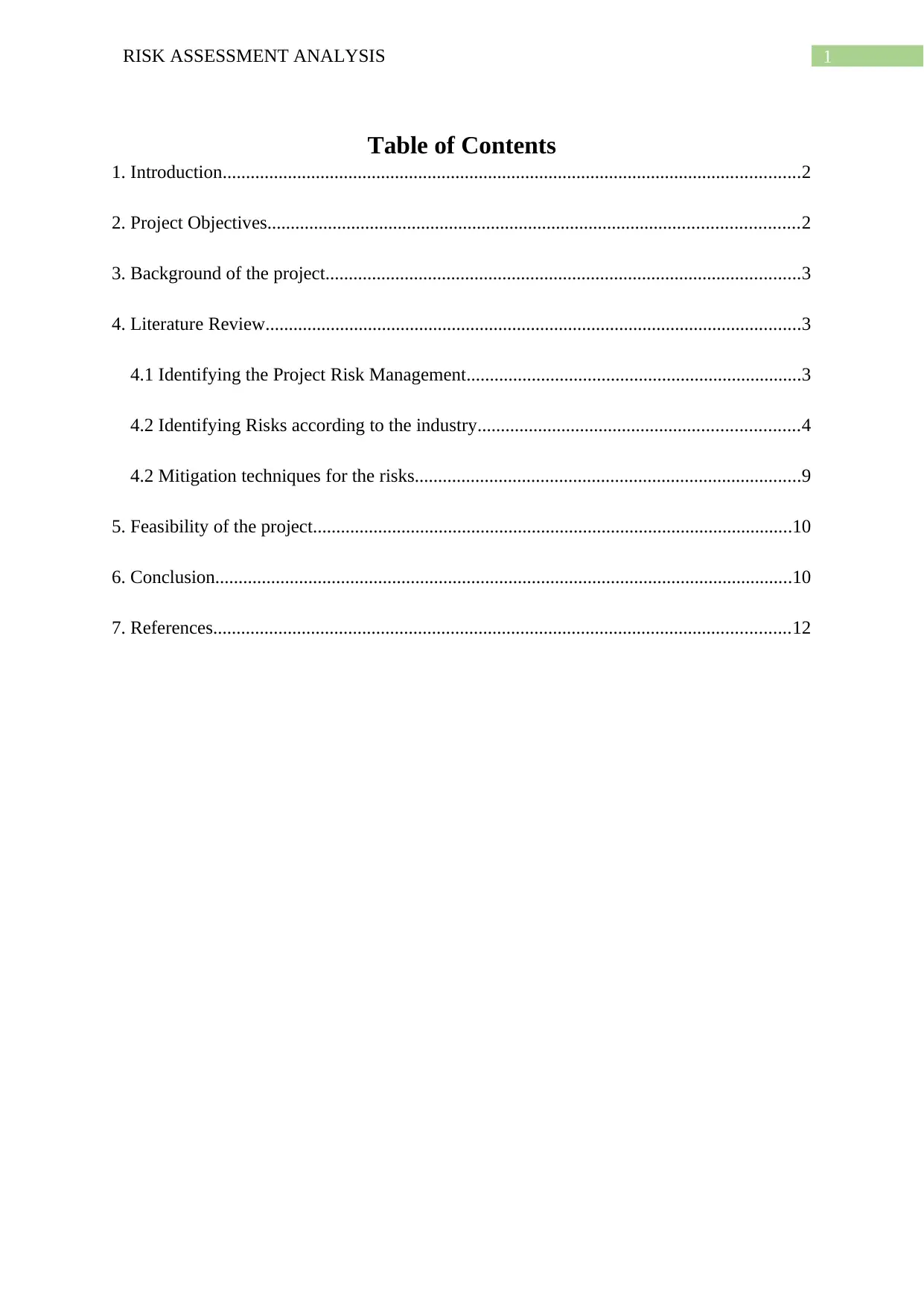
1RISK ASSESSMENT ANALYSIS
Table of Contents
1. Introduction............................................................................................................................2
2. Project Objectives..................................................................................................................2
3. Background of the project......................................................................................................3
4. Literature Review...................................................................................................................3
4.1 Identifying the Project Risk Management........................................................................3
4.2 Identifying Risks according to the industry.....................................................................4
4.2 Mitigation techniques for the risks...................................................................................9
5. Feasibility of the project.......................................................................................................10
6. Conclusion............................................................................................................................10
7. References............................................................................................................................12
Table of Contents
1. Introduction............................................................................................................................2
2. Project Objectives..................................................................................................................2
3. Background of the project......................................................................................................3
4. Literature Review...................................................................................................................3
4.1 Identifying the Project Risk Management........................................................................3
4.2 Identifying Risks according to the industry.....................................................................4
4.2 Mitigation techniques for the risks...................................................................................9
5. Feasibility of the project.......................................................................................................10
6. Conclusion............................................................................................................................10
7. References............................................................................................................................12
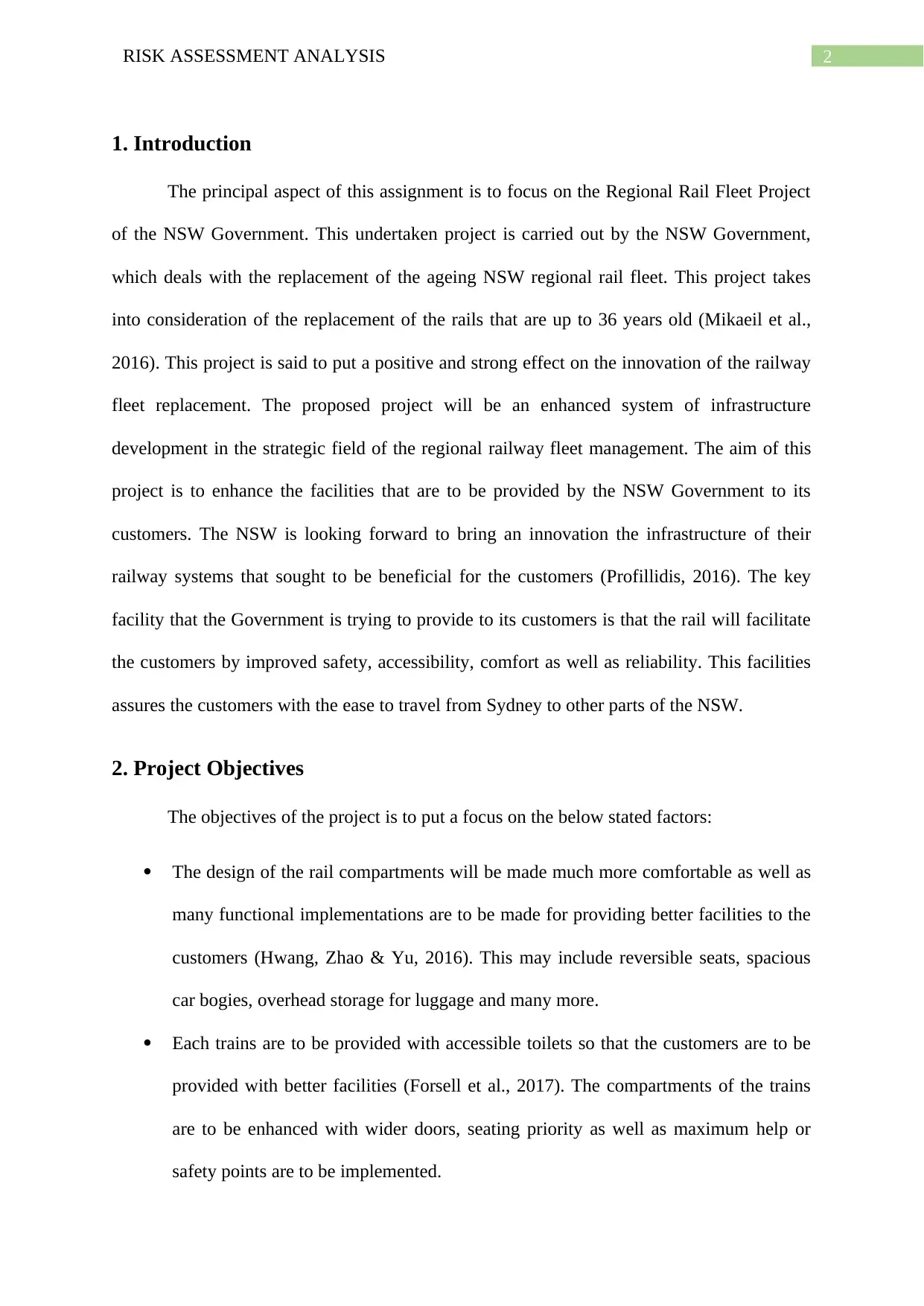
2RISK ASSESSMENT ANALYSIS
1. Introduction
The principal aspect of this assignment is to focus on the Regional Rail Fleet Project
of the NSW Government. This undertaken project is carried out by the NSW Government,
which deals with the replacement of the ageing NSW regional rail fleet. This project takes
into consideration of the replacement of the rails that are up to 36 years old (Mikaeil et al.,
2016). This project is said to put a positive and strong effect on the innovation of the railway
fleet replacement. The proposed project will be an enhanced system of infrastructure
development in the strategic field of the regional railway fleet management. The aim of this
project is to enhance the facilities that are to be provided by the NSW Government to its
customers. The NSW is looking forward to bring an innovation the infrastructure of their
railway systems that sought to be beneficial for the customers (Profillidis, 2016). The key
facility that the Government is trying to provide to its customers is that the rail will facilitate
the customers by improved safety, accessibility, comfort as well as reliability. This facilities
assures the customers with the ease to travel from Sydney to other parts of the NSW.
2. Project Objectives
The objectives of the project is to put a focus on the below stated factors:
The design of the rail compartments will be made much more comfortable as well as
many functional implementations are to be made for providing better facilities to the
customers (Hwang, Zhao & Yu, 2016). This may include reversible seats, spacious
car bogies, overhead storage for luggage and many more.
Each trains are to be provided with accessible toilets so that the customers are to be
provided with better facilities (Forsell et al., 2017). The compartments of the trains
are to be enhanced with wider doors, seating priority as well as maximum help or
safety points are to be implemented.
1. Introduction
The principal aspect of this assignment is to focus on the Regional Rail Fleet Project
of the NSW Government. This undertaken project is carried out by the NSW Government,
which deals with the replacement of the ageing NSW regional rail fleet. This project takes
into consideration of the replacement of the rails that are up to 36 years old (Mikaeil et al.,
2016). This project is said to put a positive and strong effect on the innovation of the railway
fleet replacement. The proposed project will be an enhanced system of infrastructure
development in the strategic field of the regional railway fleet management. The aim of this
project is to enhance the facilities that are to be provided by the NSW Government to its
customers. The NSW is looking forward to bring an innovation the infrastructure of their
railway systems that sought to be beneficial for the customers (Profillidis, 2016). The key
facility that the Government is trying to provide to its customers is that the rail will facilitate
the customers by improved safety, accessibility, comfort as well as reliability. This facilities
assures the customers with the ease to travel from Sydney to other parts of the NSW.
2. Project Objectives
The objectives of the project is to put a focus on the below stated factors:
The design of the rail compartments will be made much more comfortable as well as
many functional implementations are to be made for providing better facilities to the
customers (Hwang, Zhao & Yu, 2016). This may include reversible seats, spacious
car bogies, overhead storage for luggage and many more.
Each trains are to be provided with accessible toilets so that the customers are to be
provided with better facilities (Forsell et al., 2017). The compartments of the trains
are to be enhanced with wider doors, seating priority as well as maximum help or
safety points are to be implemented.
⊘ This is a preview!⊘
Do you want full access?
Subscribe today to unlock all pages.

Trusted by 1+ million students worldwide
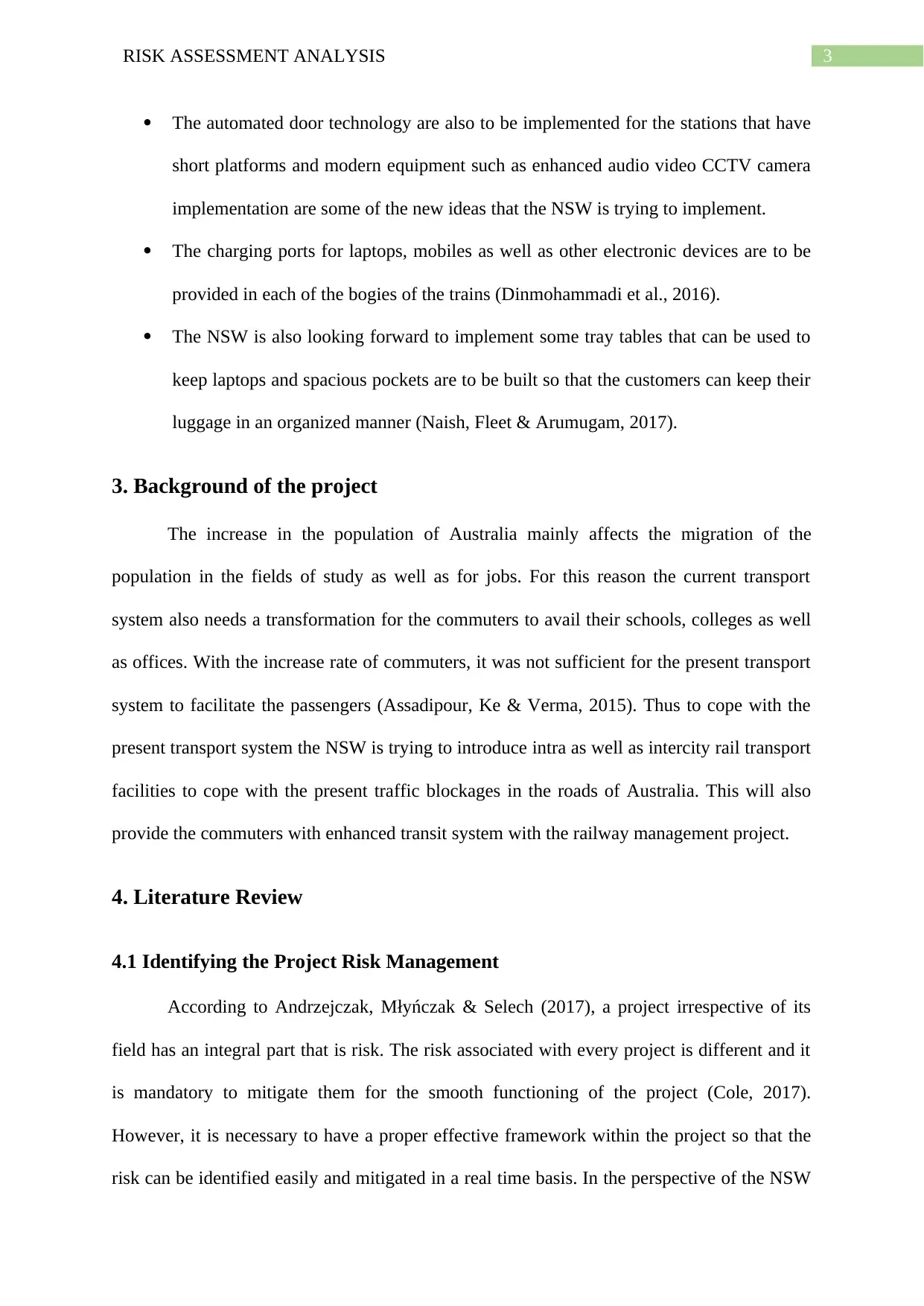
3RISK ASSESSMENT ANALYSIS
The automated door technology are also to be implemented for the stations that have
short platforms and modern equipment such as enhanced audio video CCTV camera
implementation are some of the new ideas that the NSW is trying to implement.
The charging ports for laptops, mobiles as well as other electronic devices are to be
provided in each of the bogies of the trains (Dinmohammadi et al., 2016).
The NSW is also looking forward to implement some tray tables that can be used to
keep laptops and spacious pockets are to be built so that the customers can keep their
luggage in an organized manner (Naish, Fleet & Arumugam, 2017).
3. Background of the project
The increase in the population of Australia mainly affects the migration of the
population in the fields of study as well as for jobs. For this reason the current transport
system also needs a transformation for the commuters to avail their schools, colleges as well
as offices. With the increase rate of commuters, it was not sufficient for the present transport
system to facilitate the passengers (Assadipour, Ke & Verma, 2015). Thus to cope with the
present transport system the NSW is trying to introduce intra as well as intercity rail transport
facilities to cope with the present traffic blockages in the roads of Australia. This will also
provide the commuters with enhanced transit system with the railway management project.
4. Literature Review
4.1 Identifying the Project Risk Management
According to Andrzejczak, Młyńczak & Selech (2017), a project irrespective of its
field has an integral part that is risk. The risk associated with every project is different and it
is mandatory to mitigate them for the smooth functioning of the project (Cole, 2017).
However, it is necessary to have a proper effective framework within the project so that the
risk can be identified easily and mitigated in a real time basis. In the perspective of the NSW
The automated door technology are also to be implemented for the stations that have
short platforms and modern equipment such as enhanced audio video CCTV camera
implementation are some of the new ideas that the NSW is trying to implement.
The charging ports for laptops, mobiles as well as other electronic devices are to be
provided in each of the bogies of the trains (Dinmohammadi et al., 2016).
The NSW is also looking forward to implement some tray tables that can be used to
keep laptops and spacious pockets are to be built so that the customers can keep their
luggage in an organized manner (Naish, Fleet & Arumugam, 2017).
3. Background of the project
The increase in the population of Australia mainly affects the migration of the
population in the fields of study as well as for jobs. For this reason the current transport
system also needs a transformation for the commuters to avail their schools, colleges as well
as offices. With the increase rate of commuters, it was not sufficient for the present transport
system to facilitate the passengers (Assadipour, Ke & Verma, 2015). Thus to cope with the
present transport system the NSW is trying to introduce intra as well as intercity rail transport
facilities to cope with the present traffic blockages in the roads of Australia. This will also
provide the commuters with enhanced transit system with the railway management project.
4. Literature Review
4.1 Identifying the Project Risk Management
According to Andrzejczak, Młyńczak & Selech (2017), a project irrespective of its
field has an integral part that is risk. The risk associated with every project is different and it
is mandatory to mitigate them for the smooth functioning of the project (Cole, 2017).
However, it is necessary to have a proper effective framework within the project so that the
risk can be identified easily and mitigated in a real time basis. In the perspective of the NSW
Paraphrase This Document
Need a fresh take? Get an instant paraphrase of this document with our AI Paraphraser
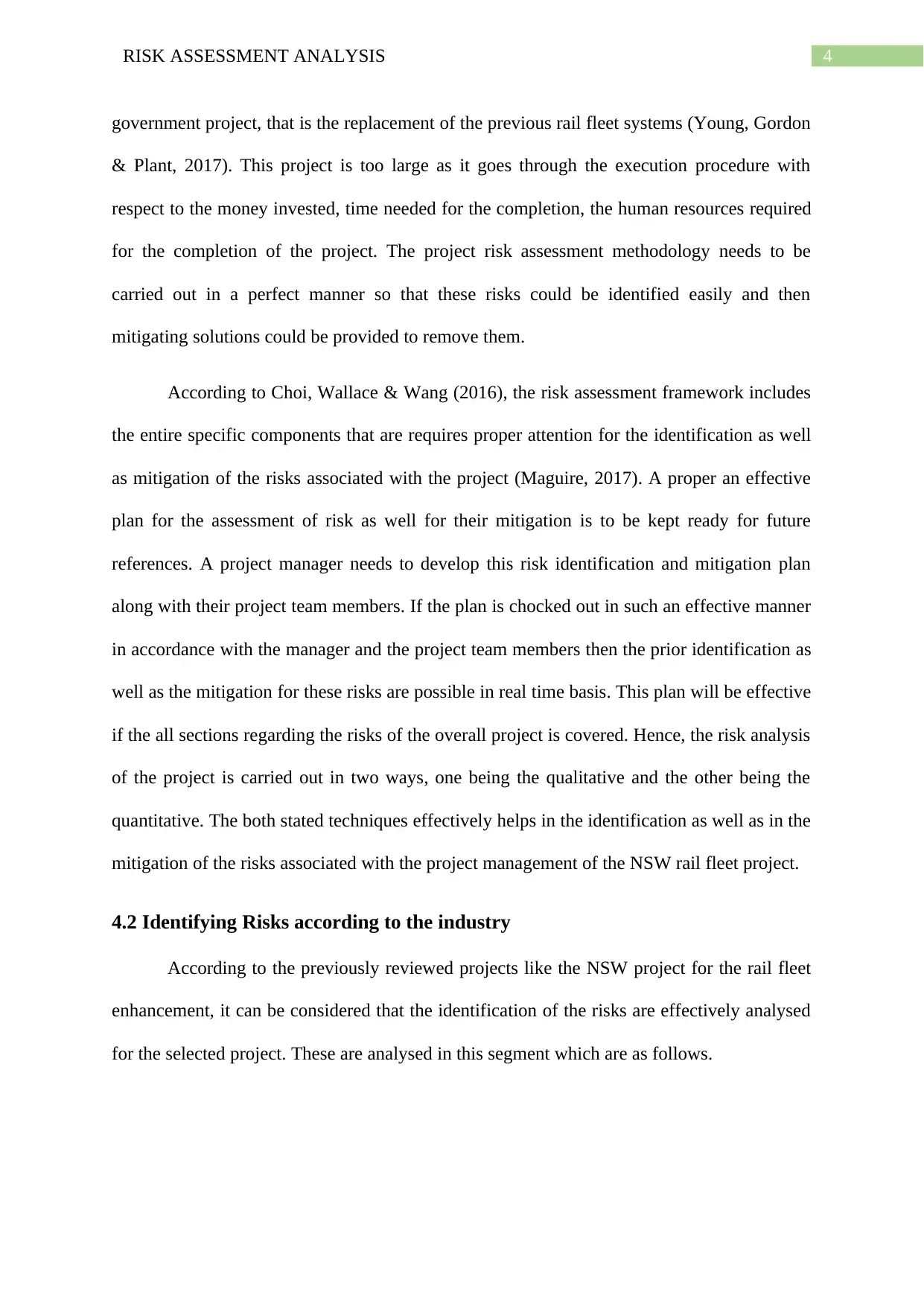
4RISK ASSESSMENT ANALYSIS
government project, that is the replacement of the previous rail fleet systems (Young, Gordon
& Plant, 2017). This project is too large as it goes through the execution procedure with
respect to the money invested, time needed for the completion, the human resources required
for the completion of the project. The project risk assessment methodology needs to be
carried out in a perfect manner so that these risks could be identified easily and then
mitigating solutions could be provided to remove them.
According to Choi, Wallace & Wang (2016), the risk assessment framework includes
the entire specific components that are requires proper attention for the identification as well
as mitigation of the risks associated with the project (Maguire, 2017). A proper an effective
plan for the assessment of risk as well for their mitigation is to be kept ready for future
references. A project manager needs to develop this risk identification and mitigation plan
along with their project team members. If the plan is chocked out in such an effective manner
in accordance with the manager and the project team members then the prior identification as
well as the mitigation for these risks are possible in real time basis. This plan will be effective
if the all sections regarding the risks of the overall project is covered. Hence, the risk analysis
of the project is carried out in two ways, one being the qualitative and the other being the
quantitative. The both stated techniques effectively helps in the identification as well as in the
mitigation of the risks associated with the project management of the NSW rail fleet project.
4.2 Identifying Risks according to the industry
According to the previously reviewed projects like the NSW project for the rail fleet
enhancement, it can be considered that the identification of the risks are effectively analysed
for the selected project. These are analysed in this segment which are as follows.
government project, that is the replacement of the previous rail fleet systems (Young, Gordon
& Plant, 2017). This project is too large as it goes through the execution procedure with
respect to the money invested, time needed for the completion, the human resources required
for the completion of the project. The project risk assessment methodology needs to be
carried out in a perfect manner so that these risks could be identified easily and then
mitigating solutions could be provided to remove them.
According to Choi, Wallace & Wang (2016), the risk assessment framework includes
the entire specific components that are requires proper attention for the identification as well
as mitigation of the risks associated with the project (Maguire, 2017). A proper an effective
plan for the assessment of risk as well for their mitigation is to be kept ready for future
references. A project manager needs to develop this risk identification and mitigation plan
along with their project team members. If the plan is chocked out in such an effective manner
in accordance with the manager and the project team members then the prior identification as
well as the mitigation for these risks are possible in real time basis. This plan will be effective
if the all sections regarding the risks of the overall project is covered. Hence, the risk analysis
of the project is carried out in two ways, one being the qualitative and the other being the
quantitative. The both stated techniques effectively helps in the identification as well as in the
mitigation of the risks associated with the project management of the NSW rail fleet project.
4.2 Identifying Risks according to the industry
According to the previously reviewed projects like the NSW project for the rail fleet
enhancement, it can be considered that the identification of the risks are effectively analysed
for the selected project. These are analysed in this segment which are as follows.
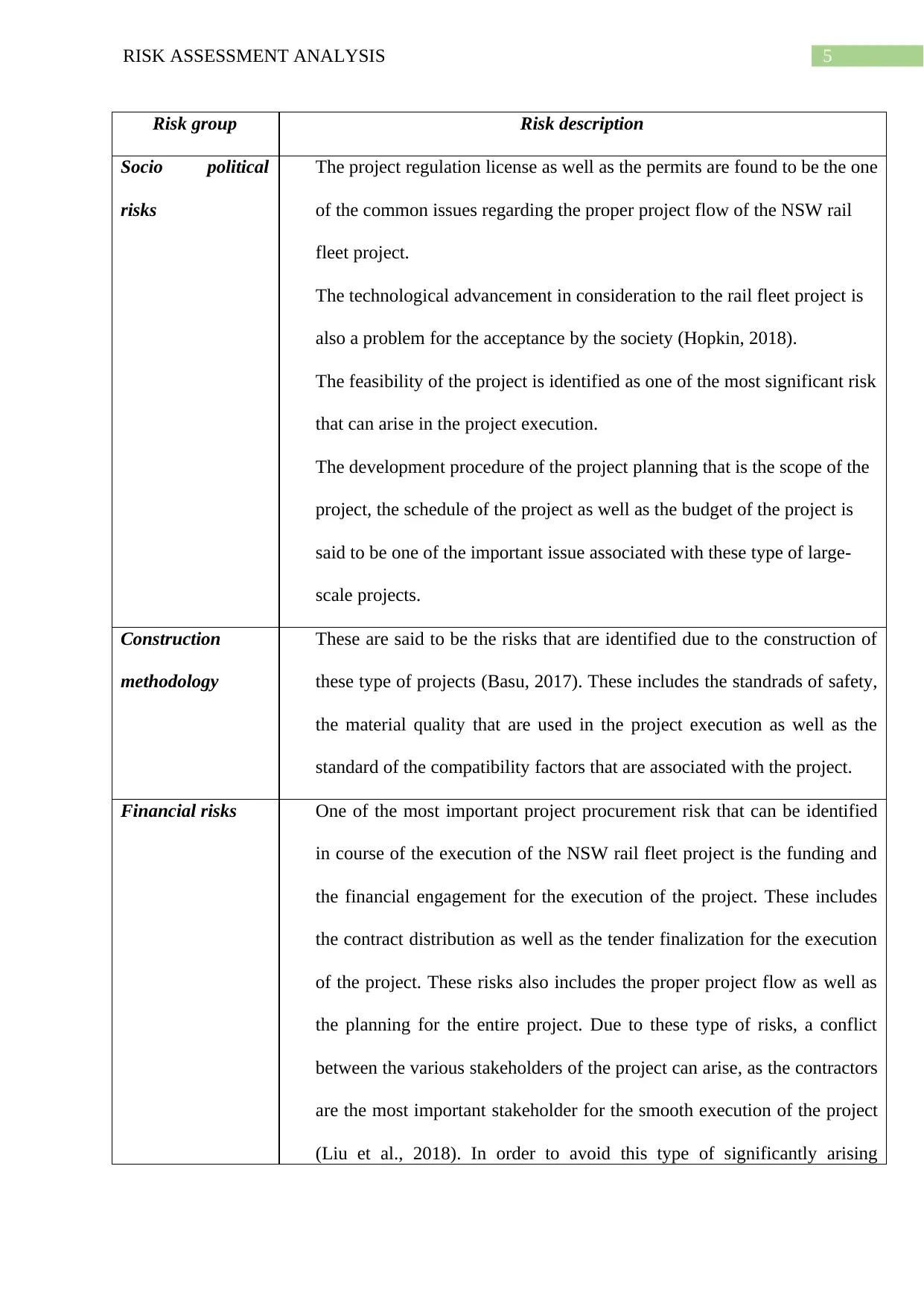
5RISK ASSESSMENT ANALYSIS
Risk group Risk description
Socio political
risks
The project regulation license as well as the permits are found to be the one
of the common issues regarding the proper project flow of the NSW rail
fleet project.
The technological advancement in consideration to the rail fleet project is
also a problem for the acceptance by the society (Hopkin, 2018).
The feasibility of the project is identified as one of the most significant risk
that can arise in the project execution.
The development procedure of the project planning that is the scope of the
project, the schedule of the project as well as the budget of the project is
said to be one of the important issue associated with these type of large-
scale projects.
Construction
methodology
These are said to be the risks that are identified due to the construction of
these type of projects (Basu, 2017). These includes the standrads of safety,
the material quality that are used in the project execution as well as the
standard of the compatibility factors that are associated with the project.
Financial risks One of the most important project procurement risk that can be identified
in course of the execution of the NSW rail fleet project is the funding and
the financial engagement for the execution of the project. These includes
the contract distribution as well as the tender finalization for the execution
of the project. These risks also includes the proper project flow as well as
the planning for the entire project. Due to these type of risks, a conflict
between the various stakeholders of the project can arise, as the contractors
are the most important stakeholder for the smooth execution of the project
(Liu et al., 2018). In order to avoid this type of significantly arising
Risk group Risk description
Socio political
risks
The project regulation license as well as the permits are found to be the one
of the common issues regarding the proper project flow of the NSW rail
fleet project.
The technological advancement in consideration to the rail fleet project is
also a problem for the acceptance by the society (Hopkin, 2018).
The feasibility of the project is identified as one of the most significant risk
that can arise in the project execution.
The development procedure of the project planning that is the scope of the
project, the schedule of the project as well as the budget of the project is
said to be one of the important issue associated with these type of large-
scale projects.
Construction
methodology
These are said to be the risks that are identified due to the construction of
these type of projects (Basu, 2017). These includes the standrads of safety,
the material quality that are used in the project execution as well as the
standard of the compatibility factors that are associated with the project.
Financial risks One of the most important project procurement risk that can be identified
in course of the execution of the NSW rail fleet project is the funding and
the financial engagement for the execution of the project. These includes
the contract distribution as well as the tender finalization for the execution
of the project. These risks also includes the proper project flow as well as
the planning for the entire project. Due to these type of risks, a conflict
between the various stakeholders of the project can arise, as the contractors
are the most important stakeholder for the smooth execution of the project
(Liu et al., 2018). In order to avoid this type of significantly arising
⊘ This is a preview!⊘
Do you want full access?
Subscribe today to unlock all pages.

Trusted by 1+ million students worldwide

6RISK ASSESSMENT ANALYSIS
problem it is necessary for the project manager to effectively select the
contractors as well as the stakeholders that will be participating for the
execution of the project. Therefore, it can be said that the financial
constraints is one of the most significant issue in accordance for the project
execution.
Design risks This part of the risks is associated with the project design of the NSW rail
fleet project. This includes the part of the implemented design regarding
the innovative features that are to be used for the enhancement of the
railway bogies. This also includes the fact that if any last moment changes
are needed for the project innovation can put an adverse impact in the
project execution project. This will also put an impact in the financial
aspects of the changes that are needed for the project. Another impact may
be the fact of the design procurement procedure that already implemented
might not be favourable for the common people. Hence, these contexts
must be kept in consideration for the smooth execution of the project.
Management risks This includes the fact of the communication between the overall
managerial sections that are associated with the project execution. This
includes the fact of the communication between the various stakeholders
associated with the project (Andrzejczak, Młyńczak & Selech, 2017). If the
communication is not carried out effectively within the stakeholders of the
organization, it will put an adverse effect in the execution of the project.
This will lead to the improper planning of the project, which will result in
the improper execution of the project. This risks arises in the project due to
a sudden change in the managerial structure of the project as well as if
there arises in the improper management of the stakeholders within the
problem it is necessary for the project manager to effectively select the
contractors as well as the stakeholders that will be participating for the
execution of the project. Therefore, it can be said that the financial
constraints is one of the most significant issue in accordance for the project
execution.
Design risks This part of the risks is associated with the project design of the NSW rail
fleet project. This includes the part of the implemented design regarding
the innovative features that are to be used for the enhancement of the
railway bogies. This also includes the fact that if any last moment changes
are needed for the project innovation can put an adverse impact in the
project execution project. This will also put an impact in the financial
aspects of the changes that are needed for the project. Another impact may
be the fact of the design procurement procedure that already implemented
might not be favourable for the common people. Hence, these contexts
must be kept in consideration for the smooth execution of the project.
Management risks This includes the fact of the communication between the overall
managerial sections that are associated with the project execution. This
includes the fact of the communication between the various stakeholders
associated with the project (Andrzejczak, Młyńczak & Selech, 2017). If the
communication is not carried out effectively within the stakeholders of the
organization, it will put an adverse effect in the execution of the project.
This will lead to the improper planning of the project, which will result in
the improper execution of the project. This risks arises in the project due to
a sudden change in the managerial structure of the project as well as if
there arises in the improper management of the stakeholders within the
Paraphrase This Document
Need a fresh take? Get an instant paraphrase of this document with our AI Paraphraser
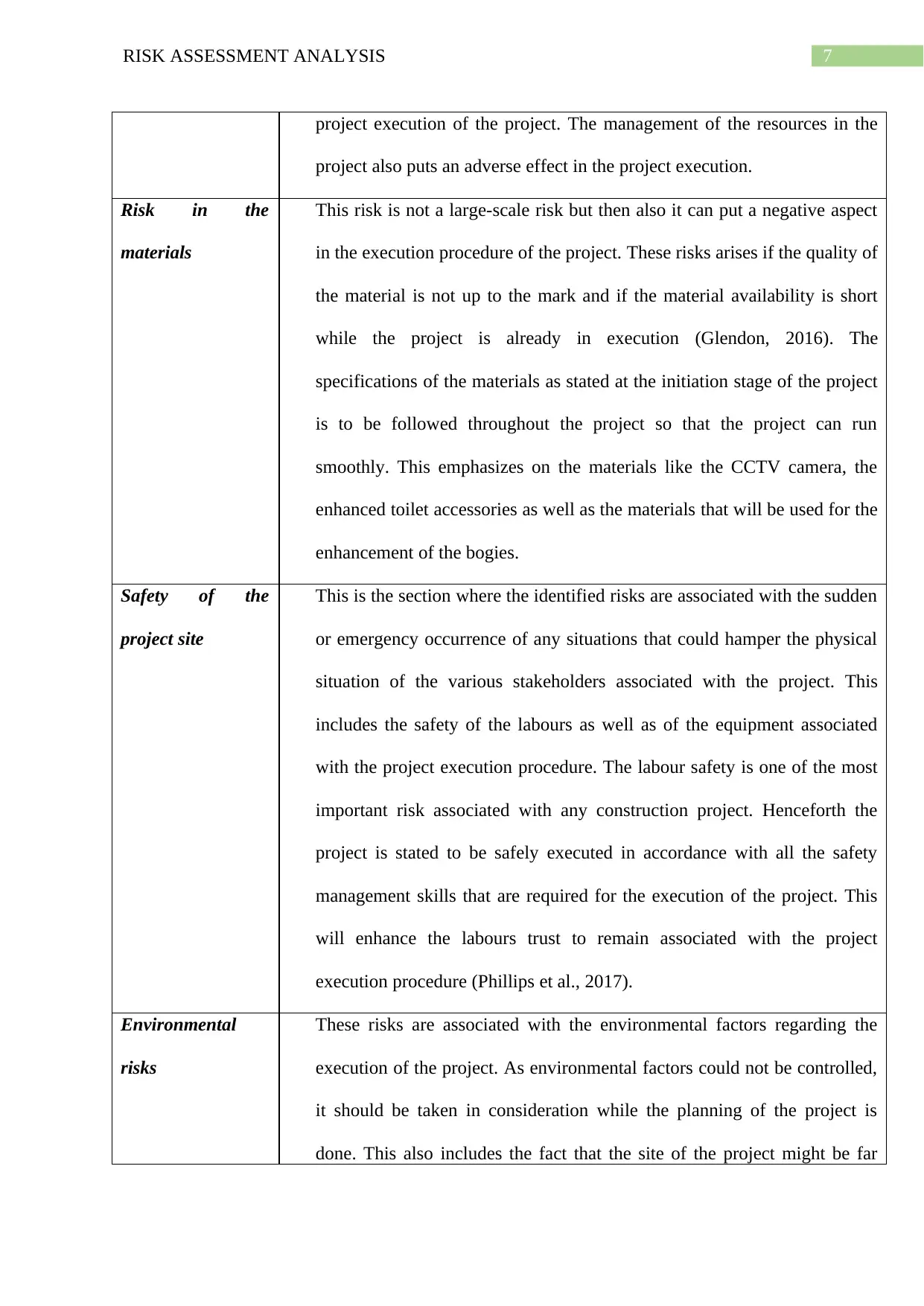
7RISK ASSESSMENT ANALYSIS
project execution of the project. The management of the resources in the
project also puts an adverse effect in the project execution.
Risk in the
materials
This risk is not a large-scale risk but then also it can put a negative aspect
in the execution procedure of the project. These risks arises if the quality of
the material is not up to the mark and if the material availability is short
while the project is already in execution (Glendon, 2016). The
specifications of the materials as stated at the initiation stage of the project
is to be followed throughout the project so that the project can run
smoothly. This emphasizes on the materials like the CCTV camera, the
enhanced toilet accessories as well as the materials that will be used for the
enhancement of the bogies.
Safety of the
project site
This is the section where the identified risks are associated with the sudden
or emergency occurrence of any situations that could hamper the physical
situation of the various stakeholders associated with the project. This
includes the safety of the labours as well as of the equipment associated
with the project execution procedure. The labour safety is one of the most
important risk associated with any construction project. Henceforth the
project is stated to be safely executed in accordance with all the safety
management skills that are required for the execution of the project. This
will enhance the labours trust to remain associated with the project
execution procedure (Phillips et al., 2017).
Environmental
risks
These risks are associated with the environmental factors regarding the
execution of the project. As environmental factors could not be controlled,
it should be taken in consideration while the planning of the project is
done. This also includes the fact that the site of the project might be far
project execution of the project. The management of the resources in the
project also puts an adverse effect in the project execution.
Risk in the
materials
This risk is not a large-scale risk but then also it can put a negative aspect
in the execution procedure of the project. These risks arises if the quality of
the material is not up to the mark and if the material availability is short
while the project is already in execution (Glendon, 2016). The
specifications of the materials as stated at the initiation stage of the project
is to be followed throughout the project so that the project can run
smoothly. This emphasizes on the materials like the CCTV camera, the
enhanced toilet accessories as well as the materials that will be used for the
enhancement of the bogies.
Safety of the
project site
This is the section where the identified risks are associated with the sudden
or emergency occurrence of any situations that could hamper the physical
situation of the various stakeholders associated with the project. This
includes the safety of the labours as well as of the equipment associated
with the project execution procedure. The labour safety is one of the most
important risk associated with any construction project. Henceforth the
project is stated to be safely executed in accordance with all the safety
management skills that are required for the execution of the project. This
will enhance the labours trust to remain associated with the project
execution procedure (Phillips et al., 2017).
Environmental
risks
These risks are associated with the environmental factors regarding the
execution of the project. As environmental factors could not be controlled,
it should be taken in consideration while the planning of the project is
done. This also includes the fact that the site of the project might be far
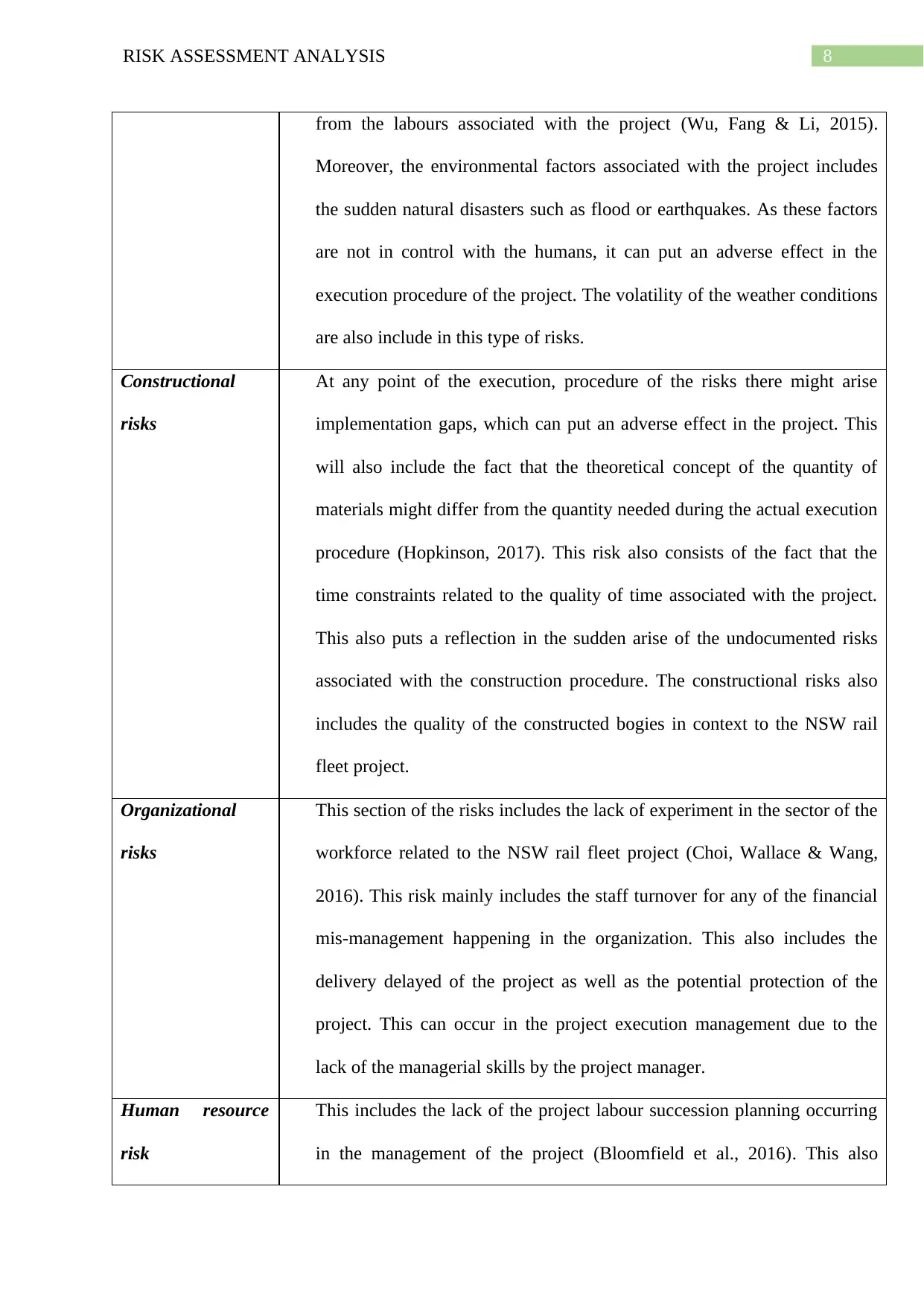
8RISK ASSESSMENT ANALYSIS
from the labours associated with the project (Wu, Fang & Li, 2015).
Moreover, the environmental factors associated with the project includes
the sudden natural disasters such as flood or earthquakes. As these factors
are not in control with the humans, it can put an adverse effect in the
execution procedure of the project. The volatility of the weather conditions
are also include in this type of risks.
Constructional
risks
At any point of the execution, procedure of the risks there might arise
implementation gaps, which can put an adverse effect in the project. This
will also include the fact that the theoretical concept of the quantity of
materials might differ from the quantity needed during the actual execution
procedure (Hopkinson, 2017). This risk also consists of the fact that the
time constraints related to the quality of time associated with the project.
This also puts a reflection in the sudden arise of the undocumented risks
associated with the construction procedure. The constructional risks also
includes the quality of the constructed bogies in context to the NSW rail
fleet project.
Organizational
risks
This section of the risks includes the lack of experiment in the sector of the
workforce related to the NSW rail fleet project (Choi, Wallace & Wang,
2016). This risk mainly includes the staff turnover for any of the financial
mis-management happening in the organization. This also includes the
delivery delayed of the project as well as the potential protection of the
project. This can occur in the project execution management due to the
lack of the managerial skills by the project manager.
Human resource
risk
This includes the lack of the project labour succession planning occurring
in the management of the project (Bloomfield et al., 2016). This also
from the labours associated with the project (Wu, Fang & Li, 2015).
Moreover, the environmental factors associated with the project includes
the sudden natural disasters such as flood or earthquakes. As these factors
are not in control with the humans, it can put an adverse effect in the
execution procedure of the project. The volatility of the weather conditions
are also include in this type of risks.
Constructional
risks
At any point of the execution, procedure of the risks there might arise
implementation gaps, which can put an adverse effect in the project. This
will also include the fact that the theoretical concept of the quantity of
materials might differ from the quantity needed during the actual execution
procedure (Hopkinson, 2017). This risk also consists of the fact that the
time constraints related to the quality of time associated with the project.
This also puts a reflection in the sudden arise of the undocumented risks
associated with the construction procedure. The constructional risks also
includes the quality of the constructed bogies in context to the NSW rail
fleet project.
Organizational
risks
This section of the risks includes the lack of experiment in the sector of the
workforce related to the NSW rail fleet project (Choi, Wallace & Wang,
2016). This risk mainly includes the staff turnover for any of the financial
mis-management happening in the organization. This also includes the
delivery delayed of the project as well as the potential protection of the
project. This can occur in the project execution management due to the
lack of the managerial skills by the project manager.
Human resource
risk
This includes the lack of the project labour succession planning occurring
in the management of the project (Bloomfield et al., 2016). This also
⊘ This is a preview!⊘
Do you want full access?
Subscribe today to unlock all pages.

Trusted by 1+ million students worldwide
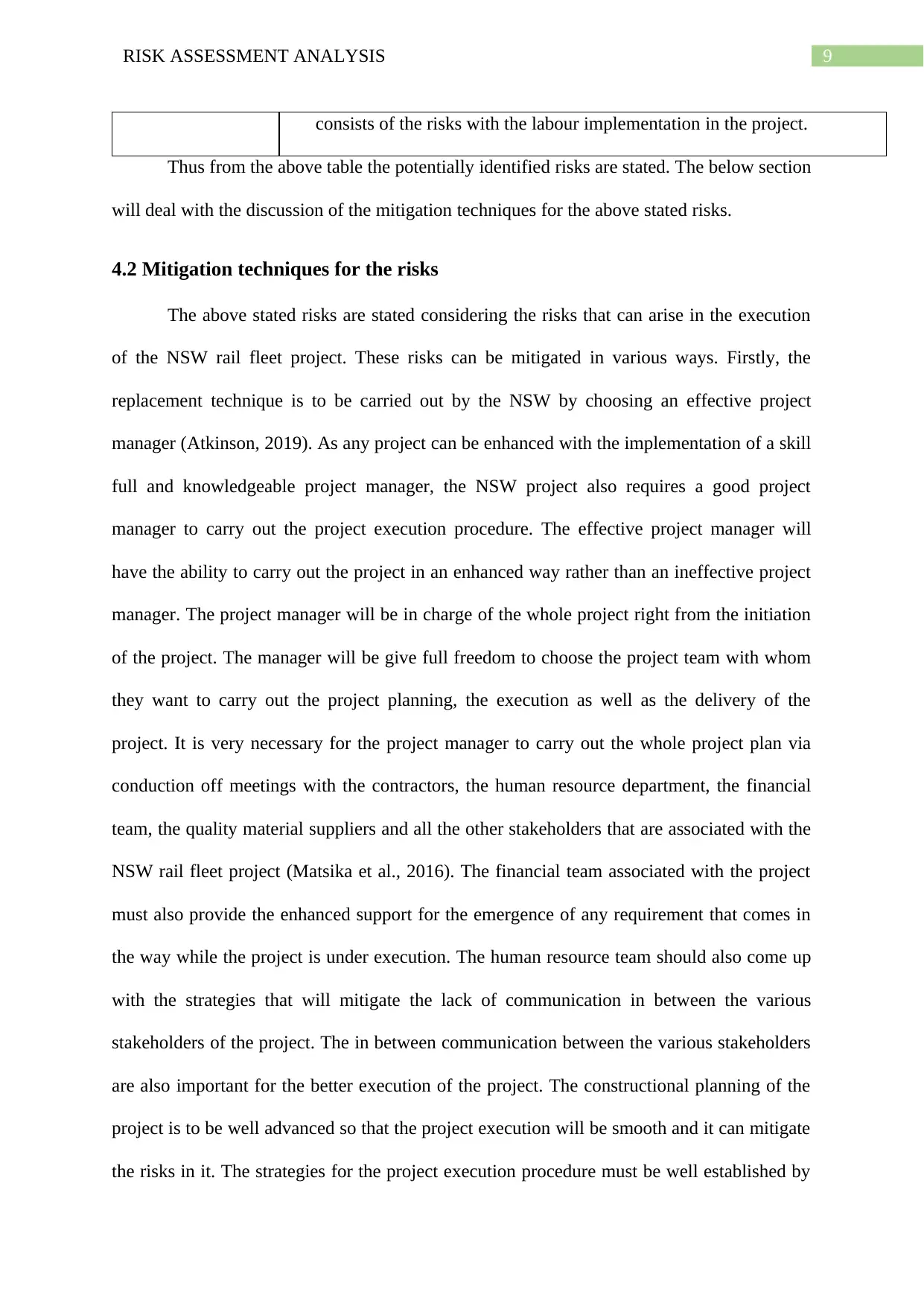
9RISK ASSESSMENT ANALYSIS
consists of the risks with the labour implementation in the project.
Thus from the above table the potentially identified risks are stated. The below section
will deal with the discussion of the mitigation techniques for the above stated risks.
4.2 Mitigation techniques for the risks
The above stated risks are stated considering the risks that can arise in the execution
of the NSW rail fleet project. These risks can be mitigated in various ways. Firstly, the
replacement technique is to be carried out by the NSW by choosing an effective project
manager (Atkinson, 2019). As any project can be enhanced with the implementation of a skill
full and knowledgeable project manager, the NSW project also requires a good project
manager to carry out the project execution procedure. The effective project manager will
have the ability to carry out the project in an enhanced way rather than an ineffective project
manager. The project manager will be in charge of the whole project right from the initiation
of the project. The manager will be give full freedom to choose the project team with whom
they want to carry out the project planning, the execution as well as the delivery of the
project. It is very necessary for the project manager to carry out the whole project plan via
conduction off meetings with the contractors, the human resource department, the financial
team, the quality material suppliers and all the other stakeholders that are associated with the
NSW rail fleet project (Matsika et al., 2016). The financial team associated with the project
must also provide the enhanced support for the emergence of any requirement that comes in
the way while the project is under execution. The human resource team should also come up
with the strategies that will mitigate the lack of communication in between the various
stakeholders of the project. The in between communication between the various stakeholders
are also important for the better execution of the project. The constructional planning of the
project is to be well advanced so that the project execution will be smooth and it can mitigate
the risks in it. The strategies for the project execution procedure must be well established by
consists of the risks with the labour implementation in the project.
Thus from the above table the potentially identified risks are stated. The below section
will deal with the discussion of the mitigation techniques for the above stated risks.
4.2 Mitigation techniques for the risks
The above stated risks are stated considering the risks that can arise in the execution
of the NSW rail fleet project. These risks can be mitigated in various ways. Firstly, the
replacement technique is to be carried out by the NSW by choosing an effective project
manager (Atkinson, 2019). As any project can be enhanced with the implementation of a skill
full and knowledgeable project manager, the NSW project also requires a good project
manager to carry out the project execution procedure. The effective project manager will
have the ability to carry out the project in an enhanced way rather than an ineffective project
manager. The project manager will be in charge of the whole project right from the initiation
of the project. The manager will be give full freedom to choose the project team with whom
they want to carry out the project planning, the execution as well as the delivery of the
project. It is very necessary for the project manager to carry out the whole project plan via
conduction off meetings with the contractors, the human resource department, the financial
team, the quality material suppliers and all the other stakeholders that are associated with the
NSW rail fleet project (Matsika et al., 2016). The financial team associated with the project
must also provide the enhanced support for the emergence of any requirement that comes in
the way while the project is under execution. The human resource team should also come up
with the strategies that will mitigate the lack of communication in between the various
stakeholders of the project. The in between communication between the various stakeholders
are also important for the better execution of the project. The constructional planning of the
project is to be well advanced so that the project execution will be smooth and it can mitigate
the risks in it. The strategies for the project execution procedure must be well established by
Paraphrase This Document
Need a fresh take? Get an instant paraphrase of this document with our AI Paraphraser
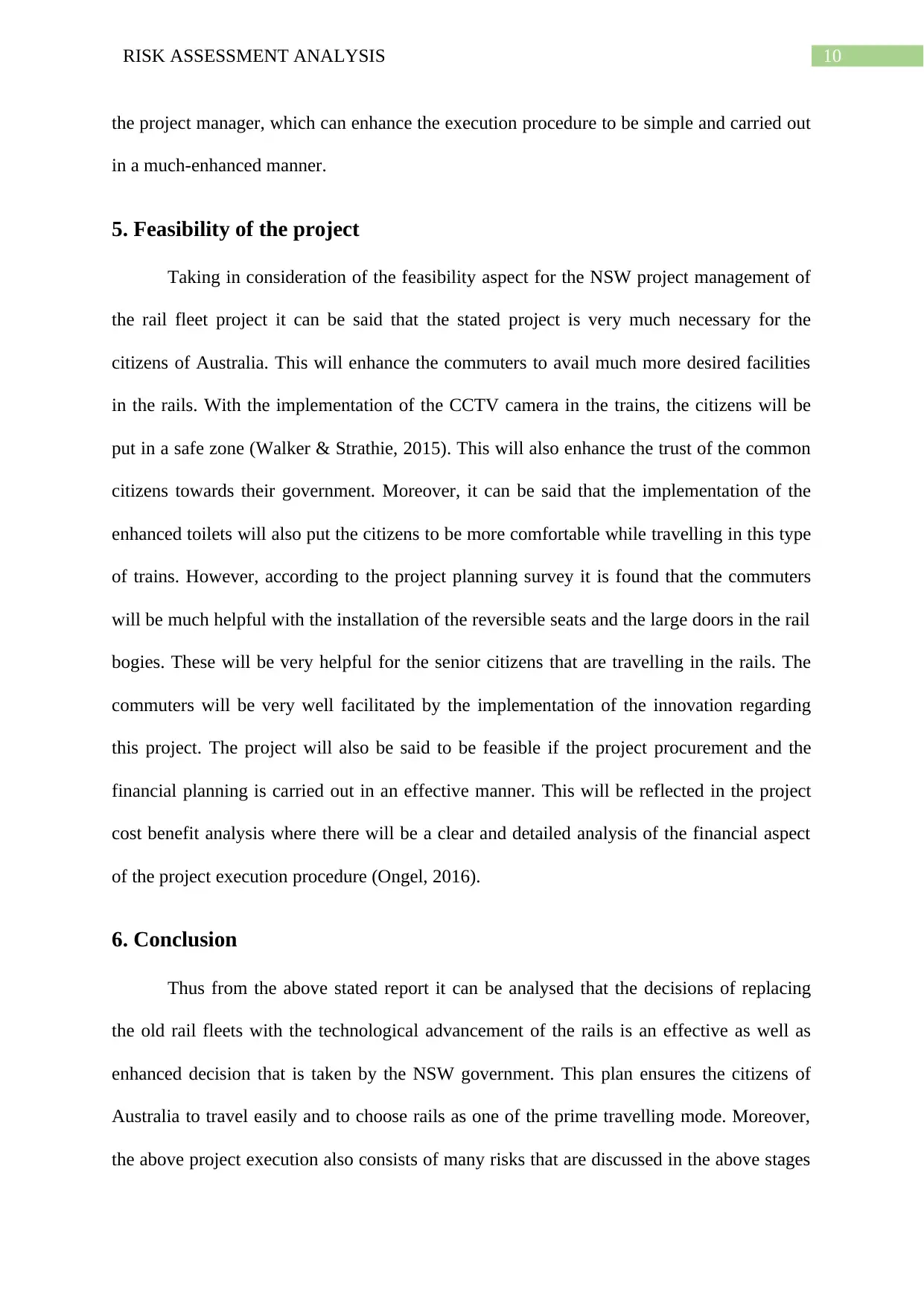
10RISK ASSESSMENT ANALYSIS
the project manager, which can enhance the execution procedure to be simple and carried out
in a much-enhanced manner.
5. Feasibility of the project
Taking in consideration of the feasibility aspect for the NSW project management of
the rail fleet project it can be said that the stated project is very much necessary for the
citizens of Australia. This will enhance the commuters to avail much more desired facilities
in the rails. With the implementation of the CCTV camera in the trains, the citizens will be
put in a safe zone (Walker & Strathie, 2015). This will also enhance the trust of the common
citizens towards their government. Moreover, it can be said that the implementation of the
enhanced toilets will also put the citizens to be more comfortable while travelling in this type
of trains. However, according to the project planning survey it is found that the commuters
will be much helpful with the installation of the reversible seats and the large doors in the rail
bogies. These will be very helpful for the senior citizens that are travelling in the rails. The
commuters will be very well facilitated by the implementation of the innovation regarding
this project. The project will also be said to be feasible if the project procurement and the
financial planning is carried out in an effective manner. This will be reflected in the project
cost benefit analysis where there will be a clear and detailed analysis of the financial aspect
of the project execution procedure (Ongel, 2016).
6. Conclusion
Thus from the above stated report it can be analysed that the decisions of replacing
the old rail fleets with the technological advancement of the rails is an effective as well as
enhanced decision that is taken by the NSW government. This plan ensures the citizens of
Australia to travel easily and to choose rails as one of the prime travelling mode. Moreover,
the above project execution also consists of many risks that are discussed in the above stages
the project manager, which can enhance the execution procedure to be simple and carried out
in a much-enhanced manner.
5. Feasibility of the project
Taking in consideration of the feasibility aspect for the NSW project management of
the rail fleet project it can be said that the stated project is very much necessary for the
citizens of Australia. This will enhance the commuters to avail much more desired facilities
in the rails. With the implementation of the CCTV camera in the trains, the citizens will be
put in a safe zone (Walker & Strathie, 2015). This will also enhance the trust of the common
citizens towards their government. Moreover, it can be said that the implementation of the
enhanced toilets will also put the citizens to be more comfortable while travelling in this type
of trains. However, according to the project planning survey it is found that the commuters
will be much helpful with the installation of the reversible seats and the large doors in the rail
bogies. These will be very helpful for the senior citizens that are travelling in the rails. The
commuters will be very well facilitated by the implementation of the innovation regarding
this project. The project will also be said to be feasible if the project procurement and the
financial planning is carried out in an effective manner. This will be reflected in the project
cost benefit analysis where there will be a clear and detailed analysis of the financial aspect
of the project execution procedure (Ongel, 2016).
6. Conclusion
Thus from the above stated report it can be analysed that the decisions of replacing
the old rail fleets with the technological advancement of the rails is an effective as well as
enhanced decision that is taken by the NSW government. This plan ensures the citizens of
Australia to travel easily and to choose rails as one of the prime travelling mode. Moreover,
the above project execution also consists of many risks that are discussed in the above stages
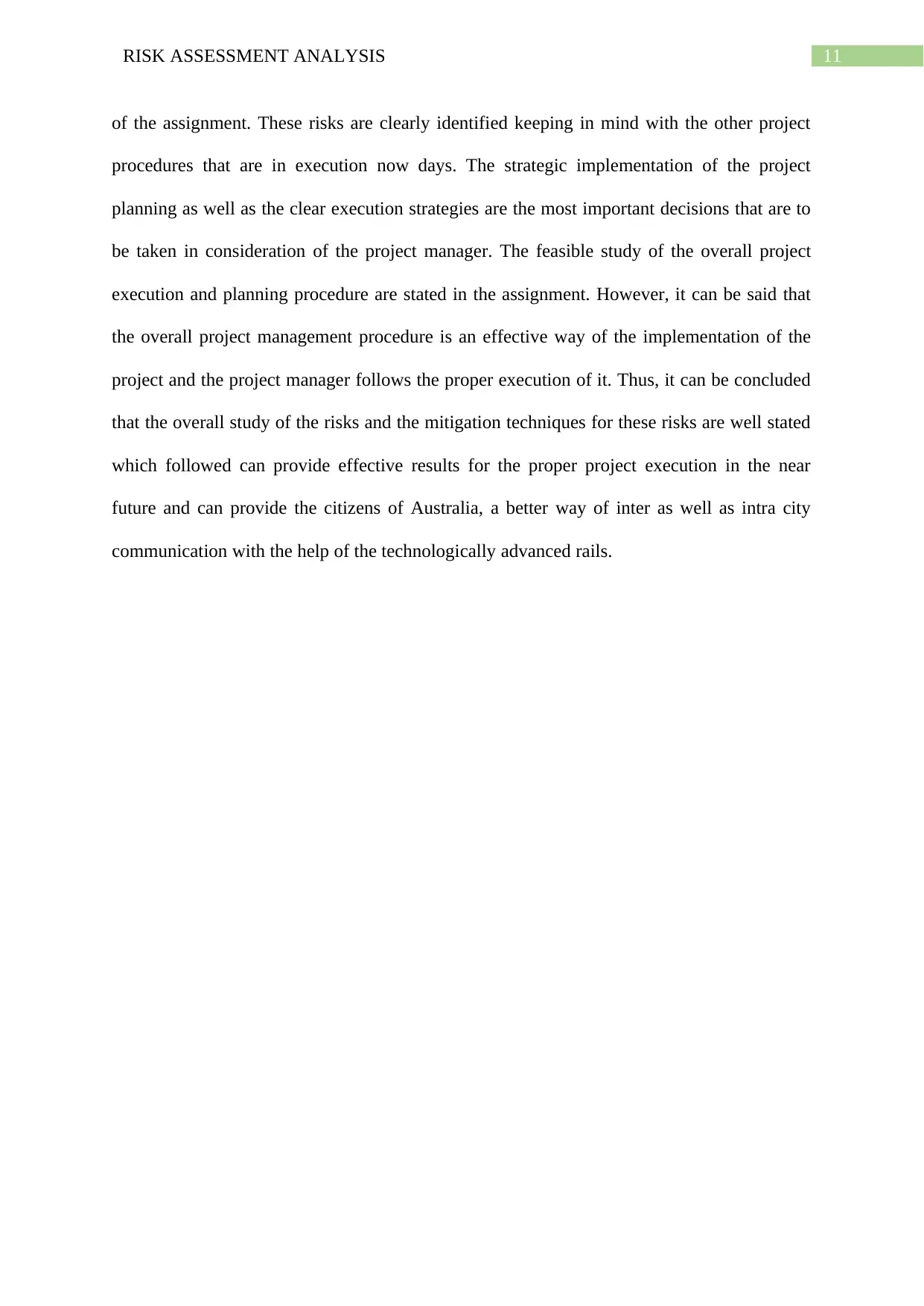
11RISK ASSESSMENT ANALYSIS
of the assignment. These risks are clearly identified keeping in mind with the other project
procedures that are in execution now days. The strategic implementation of the project
planning as well as the clear execution strategies are the most important decisions that are to
be taken in consideration of the project manager. The feasible study of the overall project
execution and planning procedure are stated in the assignment. However, it can be said that
the overall project management procedure is an effective way of the implementation of the
project and the project manager follows the proper execution of it. Thus, it can be concluded
that the overall study of the risks and the mitigation techniques for these risks are well stated
which followed can provide effective results for the proper project execution in the near
future and can provide the citizens of Australia, a better way of inter as well as intra city
communication with the help of the technologically advanced rails.
of the assignment. These risks are clearly identified keeping in mind with the other project
procedures that are in execution now days. The strategic implementation of the project
planning as well as the clear execution strategies are the most important decisions that are to
be taken in consideration of the project manager. The feasible study of the overall project
execution and planning procedure are stated in the assignment. However, it can be said that
the overall project management procedure is an effective way of the implementation of the
project and the project manager follows the proper execution of it. Thus, it can be concluded
that the overall study of the risks and the mitigation techniques for these risks are well stated
which followed can provide effective results for the proper project execution in the near
future and can provide the citizens of Australia, a better way of inter as well as intra city
communication with the help of the technologically advanced rails.
⊘ This is a preview!⊘
Do you want full access?
Subscribe today to unlock all pages.

Trusted by 1+ million students worldwide
1 out of 15
Related Documents
Your All-in-One AI-Powered Toolkit for Academic Success.
+13062052269
info@desklib.com
Available 24*7 on WhatsApp / Email
![[object Object]](/_next/static/media/star-bottom.7253800d.svg)
Unlock your academic potential
Copyright © 2020–2025 A2Z Services. All Rights Reserved. Developed and managed by ZUCOL.





